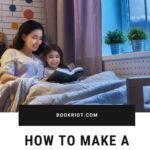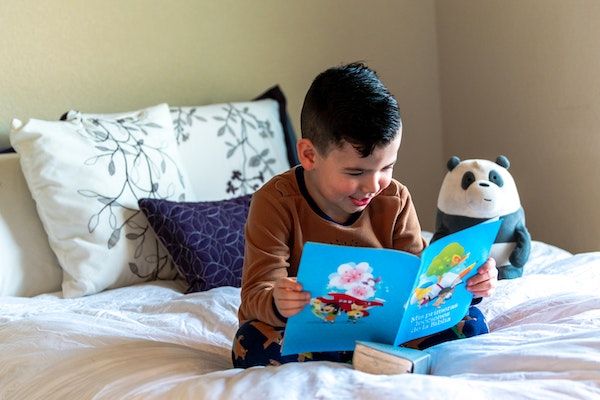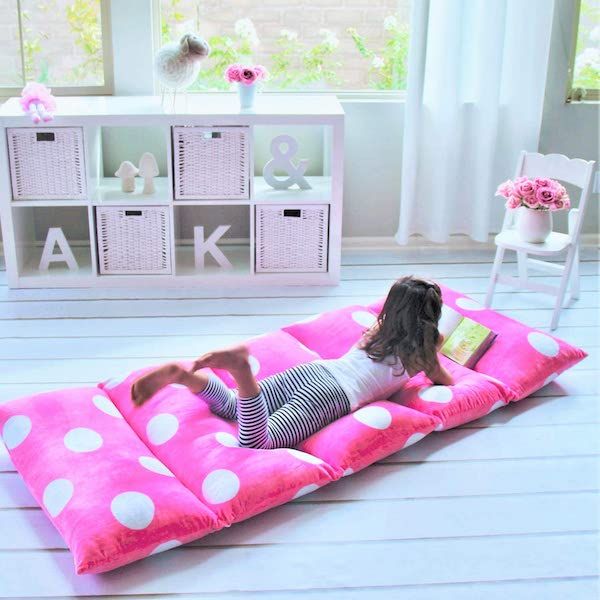It’s important to note that a specific “nook” is not always attainable depending on the living situation. It’s easy to gaze longingly at those perfect Pinterest pictures of closets turned into reading nooks, or those wondrous shelves built in the shape of trees, and feel a sense of parent guilt. I’m more likely break an IKEA shelf by looking at it before creating a DIY shelf in the shape of a tree. Creating a toddler reading nook is not about creating a perfect, Instagrammable place as much as creating a place of comfort for your child.
How To Make A Toddler Reading Nook
One of my favorite definitions of nook is “a corner or recess, especially one offering seclusion or security.” The most important goal of a toddler reading nook is creating a space—to the best of your ability, time, and resources—that is a safe, comfortable environment where your child feels secure and interested to read. My step-by-step guide is only three steps, but hopefully it’s flexible enough to fit each parent, caregiver, or educator’s needs while also leaving room for added creativity.
Step One: Use a Recognizable Space for Reading
This space can be anything from a particular seat on the couch to an entire room. Wherever you choose, help your child understand that it’s a place of reading. There are two notable spots in my home where my toddler recognizes this: my lap on the couch (I keep a pile of her most recent favorite books on the coffee table) and a corner of her playroom where there is a pillow bed and a canvas basket of books. If she wants me to read her, she often brings a book to me on the couch. If she wants to read more independently, I’ll often find her sitting on the pillow bed in her playroom, flipping through books on her own. That’s where the majority of reading happens, though it is by no means restricted to those spaces.
Step Two: Make the Toddler Reading Nook Comfortable
I mentioned a pillow bed, and it is literally a foldable bed with pillow inserts (see above image for what I mean). I wanted something that’s easy to move, easy to clean (because toddlers), and comfortable. We placed it in the corner of her playroom near the window so there’s plenty of natural light, and beside it is a canvas basket of books. She doesn’t always read on the pillow bed, but the point is she’s comfortable using it and feels secure in that space. Whether it’s a well-loved blanket, a comfortable chair or tent, have the nook be comfortable and easy to get to, otherwise your toddler might never use it.
Step Three: Make Books Accessible
In addition to having the space be accessible, a toddler reading nook works best with books within your child’s reach. Toddlers are teeny, tiny humans, and my toddler is a peanut for her size, so books are often better off sitting on the floor than on a shelf. Her favorites are within reach, often on the coffee table or in the canvas basket of books. She can grab them and either approach me to read to her, or go to her pillow bed to flip through. Pictures of floor-to-ceiling shelves are mouthwatering to behold—they are certainly fantastic for maximum book storage—but I recommend having the ones for your toddler at the bottom. I recall a tip I read in How to Raise a Reader by Pamela Paul and Maria Russo:
Additional Ideas for Toddler Reading Nooks
If the idea of creating a nook is overwhelming, remember that libraries often have wonderful reading nooks for toddlers and children. If your toddler reading nooks are confined to the couch or bed, and you’re looking for a change in scenery, check out your local library. And this post is not saying you can’t go all out building a toddler reading nook. If you want to go big, go for it! Book Riot has a few excellent lists of reading nooks, such as an idea and inspiration list for kids reading nooks and a post on tips for creating your own closet reading nook! For some Pinterest inspiration, I found this Kids Reading Nook board to be helpful for ideas as well, and many pictured there are very doable.


